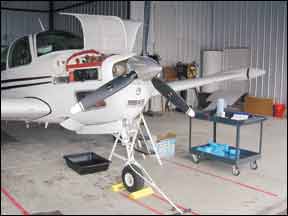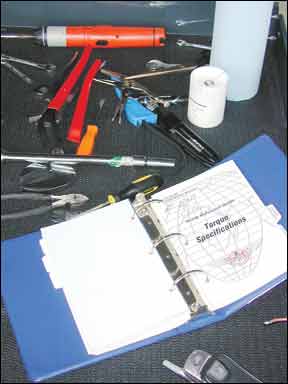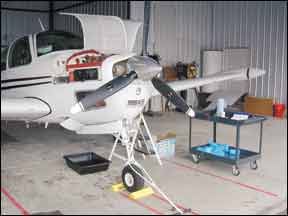Ive always been fond of pointing out one of the most dangerous things in personal aviation is a private pilot with a #2 Phillips screwdriver. Thats because Ive occasionally come across the aftermath of an owner who tried but failed to accomplish a simple inspection or maintenance task without the proper knowledge, tools or training. Too often, the results demanded a “real” mechanic to come in and 288 fix the mess. And, while Ive tried to do as much preventive maintenance on my airplane as I can, Ive often gotten in over my head and needed some professional assistance, too. Thankfully, the FAA still allows certificated pilots to work on their aircraft, performing some relatively mundane tasks. At the same time, the relevant regulations are broadly written and can cost the unsuspecting pilot/owner more in the long run than if a professional, certificated mechanic is allowed to do the work. Lets explore some of the ways we can get in over our head, and how to avoid it. Tools And Equipment The aforementioned #2 Phillips screwdriver is a common tool, both around the house and the hangar. And a lot of work-especially removing inspection covers or landing light lenses, for example-easily can be accomplished with one. But when it comes to reassembling the airplane-or even dealing with a stuck fastener, that simple screwdriver isnt going to be enough, and actually may be a liability. One of the most-common preventive maintenance tasks owners perform is changing the engine oil. On my airplane, I need a bucket, a large-diameter hose, an appropriate wrench to remove the oil filter, a Dzus tool to open up the cowling and a flat-blade screwdriver to loosen the plug on the quick-drain hose. I also need a supply of safety wire and safety-wire pliers. Engines not equipped with a quick drain-or when a spin-on oil filter isnt installed-also may require a torque wrench to reinstall the drain plug or the oil screen after cleaning. The well-equipped hangar should have all these items readily at hand. Meanwhile, the well-prepared owner/pilot also should know how to use these items, preferably after his A&P shows him the ropes. For example, wailing away on a spark plug with a long-handled wrench without paying attention to when the manufacturers torque specifications have been reached can damage a perfectly good cylinder, sometimes requiring its removal to repair the threads and remove metal shavings. Another operation where the proper tools are worth their weight in gold comes when attempting to jack the airplane and either perform maintenance on the wheels and tires or swing a retractables landing gear. If you fly a small, light taildragger, you can probably get by with an automotive-grade hydraulic jack and a suitable adapter to raise one main wheel at a time. But the average tricycle gear airplane-especially one sporting a high-mounted wing-can require purpose-designed jacks. You may also need some kind of weighted tailstand, to ensure the nosewheel stays off the hangar floor and the nose doesnt pitch over if you need to climb in or out. In any event, lifting the average tricycle-gear airplane on jacks should be a two-person operation-with one on each main-gear jack-to ensure each wing is raised more or less at the same time and the airplane remains level. It never hurts to have that extra set of hands, or eyes. And, when the airplane is high enough off the hangar floor, dont forget to use the jacks locking feature. Your jacks do have a locking feature, right? References Too often, I see owners trying to tackle a simple task without the appropriate information at hand. A common example is not knowing the appropriate torque values for, say, changing spark plugs or using an incorrect lubricant on the airframe. Instead of acquiring and using the appropriate maintenance reference materials, they depend on the airplanes POH or a hangar neighbors recommendations. Both can be woefully inaccurate. In addition to the aforementioned torque specifications for spark plugs and the like, common information available in a manufacturers maintenance documentation can include detailed procedures for servicing, removing and reinstalling various components, even those the FARs allow owner/pilots to work on without references. Adding oil and/or air to landing-gear struts is a great example, since the internal pressures involved can be much greater than expected. The FARs also allow repairing broken landing light wiring circuits, replacing and 288 servicing batteries and replacing position and landing lights. Does your POH/AFM include a detailed wiring schematic diagram? The appropriate maintenance manual does. Do you know what size wire is appropriate? Youll find that in the FAAs Advisory Circular AC 43.13-1B, Acceptable Methods, Techniques, and Practices-Aircraft Inspection and Repair. Does your POH/AFM include a list of the circuit codes often printed on the wires themselves? Thats something else you can find in the manufacturers maintenance manual. Another area where appropriate reference materials should be considered mandatory is when deciding on the appropriate lubricants, fluids and preservatives. Many POH/AFM references include details on where and with what the airframe should be lubricated periodically. But those details can change over time and a product commonly available 50 years earlier when your aircraft was manufactured may no longer be available. Theres simply no way to know what changes may have been made to the manufacturers maintenance recommendations without obtaining and using current documentation. The sidebar on the opposite page highlights some reference materials you may wish to consider. Knowledge and Training Perhaps one of the most important items you need before performing preventive maintenance on your aircraft is the appropriate knowledge and training. By itself, owning a pair of safety-wire pliers doesnt mean you can properly secure your spin-on oil filter after replacing it. Ideally, before we tackle a preventive maintenance procedure, well ask our A&P-IA or someone else with the appropriate knowledge and experience to show us the ropes. Another resource is the many type clubs offering owner/pilots varying levels of training in performing preventive maintenance on their airframes. Engine manufacturers also offer related courses, though theyre typically geared toward the certificated mechanic. And your local community college or continuing education institution may also provide appropriate training. In our experience, however, the best way to learn how to do these things is to go the owner-assisted annual inspection route, presuming your shop or IA allows it. Youll spend at least a couple of days on the hangar floor opening inspection panels, get extremely dirty and have a few more aches and pains at the end of it. But youll also learn a lot about your airplane, and where some of its looming problem areas might be in the future, but which can be deferred for now. Most important, youll have the opportunity to perform many of the tasks allowed under the FARs while your IA looks on, learning how and how not to use the appropriate tools in the process. That experience is invaluable if you plan to do any preventive maintenance yourself. Finally, dont forget to make the appropriate logbook entries. Conclusion Personal aircraft arent falling out of the sky each day because their owners didnt use the manufacturers recommended grease in the wheel bearings. But most of us didnt go through the process of becoming pilots because we lack attention to such details, either. While theres certainly the safety issue of screwing up one of the preventive maintenance tasks the FARs allow, using the correct tools, supplies documentation and other items recommended or required to maintain your aircraft helps preserve it and minimize the overall cost of ownership. By getting up close and personal with many of these tasks, we not only learn more about our aircraft, but can more easily diagnose what a new noise or vibration might mean. And with the extra money we save from performing a lot of these tasks ourselves, we can afford more training and get more utility from the aircraft. Its all good.





